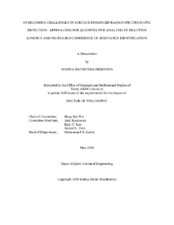| dc.description.abstract | Surface-Enhanced Raman Spectroscopy (SERS) is a modification to traditional Raman spectroscopy (RS) which inherits the high specificity of RS while featuring greatly improved sensitivity. As a result, SERS spectroscopy is capable of uniquely identifying low-abundance chemical species within complex samples. However, due to challenges in implementing SERS spectroscopy, it has not found widespread use in sensing applications. The focus of this body of research is to overcome three significant challenges to the viability of SERS, namely: (1) the poor signal reproducibility leads to unsatisfactory quantitative analysis, (2) spectral overlap and interference confounds the interpretation of complex samples, and (3) additional sample preparation requirements complicate the method, making it less suitable for many applications. These challenges were addressed through the design and implementation of specialized SERS substrates and assays. To improve the quantitative capabilities of SERS spectroscopy, an assay was developed based on a SERS-active probe functionalized with an internal calibration standard. As a result, despite significant variability in the absolute signal intensity, the self-calibrated relative signal intensity remained stable. The assay was verified by observing the SERS spectral shift throughout an aldol condensation reaction and calculating the kinetic rate constants for the reaction, which compared favorably with literature values. To simplify SERS spectral interpretation, we introduced nanopaper, consisting of glass fiber paper decorated with silver nanoparticles.
This dual-function material can be used as a SERS substrate as well as a stationary phase for paper chromatography separation, which simplifies spectral analysis by reducing the complexity of the sample. Both functions were simple to implement, requiring minimal sample preparation. Nanopaper performance was verified by successfully separating and detecting a mixture of organic dyes on nanopaper. The utility of coupling paper chromatography with SERS was further demonstrated by identifying the carotenoids lycopene and β-carotene, which have practically indistinguishable SERS spectra, in vegetable extracts. The approaches detailed herein mitigate the shortcomings of SERS methods without compromising the inherent strengths of the technique, facilitating access to a powerful analytical technique for researchers in diverse disciplines. | en |


